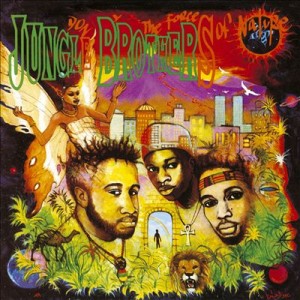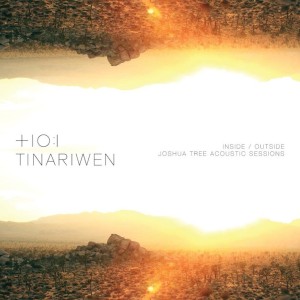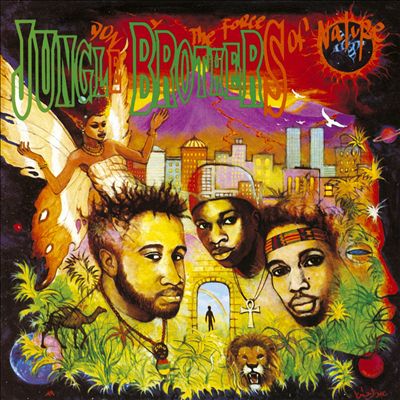Singularly preoccupied for the past year with my own Monolith Cocktail blog, I’ve found myself once more returning to (my home-from-home) God Is In The TV. Each month I will feature an exclusive to the zine collection of reviews and features on an omnivorous range of musical genres; from the golden age of Hip Hop to Modal jazz, World music and the explorations of the dammed and mischievous.
For my first edition of this “polygenesis perusal”, I pontificate on a new release from the Tuareg desert bluesmen, Tinariwen; reassess an iconic ambient totem by taking a flight over the imaginary “Fourth world” soundscapes of Jon Hassell; and celebrate the 25th anniversary of a Afrocentric Hip Hop classic: the Jungle Brother’s 1989 African odyssey, Done By The Forces Of Nature.

Jungle Brothers Done By The Forces Of Nature: The 25th anniversary of a Afrocentric Hip Hop classic.
Afrofuturism, past and present coalesced into (literally) a musical force of nature, the Jungle Brothers second transmission from “Planet Rock” in 1989, elevated Hip Hop to a whole new level of black consciousness. Aside from a number of key classics and game-changers from Public Enemy, Boogie Down Productions and the J.B.’s own peer group circle – most notably De La Soul’s 3 Feet High And Rising debut in 1988 -, the Afrocentric Done By The Forces Of Nature odyssey was a nuanced and adroit masterpiece beyond comparison.
Building on their roots-y funk-fried powered Straight Out The Jungle debut in 1988, the enlightened New York trio would deviate with the far more successful, progenitor House music specialty, (and hit single) ‘I’ll House You’; coining the “hip-house” sub genre of rap that helped spread the electronic phenomenon beyond its humble beginnings in the warehouses and tuned-in clubs of Chicago and Detroit.
That inaugural, downplayed and sophisticated Serengeti boardwalk vibe, independently released LP, may have failed to grab the zeitgeist and sell in any meaningful quantities– ahead of its time in many ways, both musically and in attitude –, yet undeterred by this seemingly commercial failure, the behemoth Warner Bros. record label signed them the following year for a new album deal, the result being their second and much more ambitiously expansive Done By The Forces Of Nature opus.
Tied in with Afrika Bambaataa’s cultural and religious exchange collective, the Universal Zulu Nation – essentially Hip Hop’s educational wing, transposed across the world, and at different times led by the concerns and social-political themes of the moment; the late 80s being dominated by the emergence in rap music and lyrical references to the Nation of Islam breakaway group, the Five-Percent Nation -, the Jungle Brothers preached a ankh and beads adorned sermon of peace, tolerance and education, imbued by a litany of religious (Islam, Hinduism, Buddhism) and spiritual influences (from the sanctified Sanskrit tome Bhagavad Gita which influenced the album’s title, to Ancient Egypt).
If De La Soul’s groundbreaking 3 Feet High And Rising was the Haight-Ashbury psychedelic epiphany of Hip Hop, then the Jungle Brothers mirrored the black conscious development and concerns of soul, funk and jazz in the late 60s and early 70s. Absorbing as those genres did, a worldly travailed musical excursion back to the “motherland”; through the ages in celebration of the roots of humanity and “the first civilisation on Earth” (namely the Egyptians), the trio donned the costumes of their ancestors to further the course of black history. From the cover of the album itself, a pastel shaded throwback to the cosmological and roots-y artwork of Osibisa, and a far less salacious and garish, Funkadelic, to the samples and jungle metaphor-rich language that permeated throughout the multi-layered opus, the call of Africa proved fertile and alluring.
As the Fatback Band dampened drum break and Roy Ayers ‘Black Family’ funk guitar borrowed samples, ‘Acknowledge Your Own’ history lesson (a more subtly tribal scion to KRS-1’s ‘more bombastic classroom diatribes) states, the trio have adopted the synonymous red, black and green colours of their ancestral homeland:
“The Red’s for the blood
The Black’s for the man
The Green is the colour that stands for the land.”
Proudly unfurled in 1989, this template would go onto serve X Clan, K.M.D and the Brand Nubians well, and to a lesser extent influence the more commercially successful Arrested Development. Praising the toil and sweat of their elders, the J.B.’s levitate over the savannahs, waterfalls, dunes and near-utopian landscapes of a continent on the garden of Earthly delights, crystallised, opening funked ‘Beyond this World’ (sampling the birth of Hip Hop itself with an intro from Grandmaster & Melle Mel’s ‘White Lines’, and samples from Stetsasonic to Bambaataa), and coax a metaphor heavy guiding light on the “fox that rocks the box”, concrete jungle set ‘Sunshine’.
The spiritualist poetics just keep rolling, especially on the double bass bended and spiritual jazz saxophone, accompanied title track; smoothly traveling a cosmological pathway through Earth, wind and fire, dropping science and Biblical references as they go. The quality continues with the magnificent reverb echoed, swinging from the (di)vine ‘Beeds On A String’, The Blackbyrds and Parliament backed, and de-tuned orchestral warm up ‘Tribe Vibes’ and DJ Sammy B, African bombastic, anthem work out ‘Good Newz Comin’’ (which I even petitioned Tom Robinson on 6Music to play this year as part of his African influenced playlist; a request he thankfully obliged). But among the most touching, if plaintive paeans, ‘Black Woman’ stands out as the albums stirring requiem and soul. Backed by the golden, doleful tones of Soul II Soul’s Caron Wheeler, and imbued as well as a riff on The Last Poets own tribute to the saintly, nurturing and motherly centre of their world, this subtly crafted love song, features the continental language of love itself, with Lucian (future subject of A Tribe Called Quest) of Paris’s earnest contribution.
Joining forces in the late Eighties to bolster the like-minded Native Tongues collective, the J.B.’s were closer in themes and doctrine to fellow members, A Tribe Called Quest, than De La Soul or Monie Love. The spirit of the Prince Paul produced trio and their psychedelic daisy age vision, was far more laidback and devoid of the sympathetic religious, chiefly the Five-Percent Nation, undertones. Core member Queen Latifah, and a whole host of affiliated, but not strictly speaking, members of that group, would name check and allude to the teachings of not only this movement but also the Nation Of Islam, which the Five Percent broke away from in the late Sixties (founded by a former student of Malcolm X, Clarence Edward Smith in Harlem in 1964, after a theological spate with the Nation Of Islam). A doctrine that both preaches a positive global comradeship of learning and peace for followers, yet also wildly supports the most unbelievable, conspiracist claptrap – strangely not a million miles from L. Ron Hubbard’s Scientology – about the origins of the races, in particular the “alien” whites, created as the myth goes, by a black scientist called Yakub, 6,600 years ago: understandable when your forefathers were enslaved, but still, uncomfortable for the white “devils”; standing in as the grand inquisitors and instigators of all the world’s ills.
Despite this rhetoric – taken to a whole new level on Public Enemy’s Fear Of A Black Planet in 1990 – the J.B.’s offered an olive branch to listeners in the shape of their more funk-fired and “good times” Zapp and Ohio Players embellished party tunes. “All decked out in my tiger-skinned suit/ Hair braided up and my Jungle Brother boots”; the finger-snapping, sauntering ‘Feelin’ Alright’ strolls down the sunnier side of the urban jungle – a moiety to the following ‘Sunshine’ track – scene, whilst “What “U” Waitin’ 4’ is an extended, but more fruits of nature quality, Hip House teaser, and “U” Make Me Sweat’ is a Cameo vocoder warbled dance floor meets strident Parliament funk stonker. That Sun Ra meets George Clinton at the funkenstien space station vibe can be found on the Eastern bazaar flavoured ‘Belly Dancin’ Dina’; the salacious, swaying hipped, object of the Brother’s affection powered along by the Hardcore Jollies of Funkadelic’s ‘You Scared The lovin’ Outta Me’ and both the Ohio Players ‘Funky Worm’ and Alphonso Johnson’s ‘On The Case’.
As is customary with the Hip Hop fraternity, the collaborative jam in this instance involves the Native Tongues chorus line; with De La Soul’s Mase, Posdnuos and Truguy The Dove joining Q-Tip, Monie love and J.B.’s Mike Gee and Afrika Baby Bam (another tribune and reference to the forefather of Hip Hop) in the feel good, rhyming couplet, ‘Doin’ Our Own Dang’ mission statement: all beads (or Beeds as the J.B.’s call them) on the same string.
Though ambitiously produced by the trio themselves with the prowess mastering skills of D.J. Red Alert and help of Jerry Calender, D.J. Mark The 45 King and Deee-Lite’s D.J. Tohwee, Done By The Forces Of Nature unfortunately suffers from poor recording quality, in parts far too quiet and muddy, with an overbearing distorted bass. Yet it shines through regardless; perhaps suffering from imbalance and the sampling technology of the times; the album often merging live instrumentation, programmed beats, rapping and a multitude of samples. Maybe I’m being far too disingenuous, but it’s worth mentioning, before someone else does: a possible remastered deluxe version might be nice.
Chronicling the progression of Hip Hop from performance to mix tapes and 12”, reaching a pinnacle in the late Eighties with the album format, the street sounds culture followed a similar projection as that of most musical genres. From the initial flash of inspiration and good times party movers and bloc jams to the bragging rights, hard times and thug life through to the conceptual works of art that led to a ‘golden age’ of black consciousness, Hip Hop’s massive commercial success has perhaps diminished the ambitious glories of its yesteryear – even though this roughly dated 1987 – 1994 period is exonerated by a wealth of cultish and small enthusiastic groups of fans online; and is arguably influencing the contemporary scene. The leftfield, as in all other music styles, has grown out of this disconnection between its roots and the enervated mainstream – the “vampiric” commercial music industry all but bleeding it dry of its political and religious context and revolutionary zeal. Still, artists as diverse as The Roots, MF Doom, cLOUDDEAD, Blak Twang, Edan, People Under The Stairs, Dr.Octagon (the list is endless) have and continue to carry the flame; the foundations laid down in those key “golden” years, when giants of the rap world left the biggest of booted footprints to fill. Without over aggrandizing its value, Done By The Forces Of Nature is on the top tier of the beacon pyramid; arguably one of the most important albums in the Hip Hop cannon.
Further Adventures With The Native Tongues & Friends:
To celebrate the 25th anniversary, I’ve compiled this “here” playlist of the Native Tongues brethren and sisterhood – though annoyingly, there is a lack of De La Soul on Spotify. Started by the De La as a loose base of congruous peers in 1988, off the back of a show in Boston that also featured their friends, A Tribe Called Quest, the Native Tongues was bolstered by the Jungle Brothers, our own UK heroine of Afrocentric soul and R&B, Monie Love, Queen Latifah, The Black Sheep and the Soul’s disciple, Chi-Ali. However, depending on what you read and who you listen to, affiliate members such as the X Clan, K.M.D., Leaders Of The New School, Brand Nubians and the Fu-Schnickens were all singing from the same hymn sheet and inside the campaign tent. My playlist takes this into consideration, featuring tracks from all of the above.
http://open.spotify.com/user/dominicvalvona/playlist/0PyCPpJJDQbyFClmJEl56D
And now some “reviews”…

Tinariwen ‘Tiwàyyen’ (Anti-) 17th November 2014
You could never accuse the Tuareg Bedouin collective of Tinariwen of being uncommitted. When the call is sounded these Saharan bluesmen are ready to ride into battle, guitar slung around their backs, replaced by the weapons of war. Not that we should ever excuse or glorify in any shape or form conflict and violence, the Tuareg tribes have however made it into the headlines in more recent times for just that reason. Marginalized and disgruntled at their treatment by the government in southern Mali – many having to find work and a home in a pre-civil war Libya – they fought for an independent autonomous state, called the Azawad, in northern Mali. Extremist groups such as the Ansar Dine soon hijacked the initial struggle, led in part by the National Movement for the Liberation of Azawad (who’s own personal fight dates back to 1916), their aim not just independence but an implementation of Sharia law. Civil strife did break out among the groups, as many of the fighters cherished their atavistic musical ancestral history; many had since migrating to Libya years before, been exposed to the western rock and blues version of their own ancestral culture: Hendrix being extremely popular. Draconian condemnations and edicts from the Islamist council couldn’t hope to quash their passion for music – though not wholly banned; only the designated forms of prayer and worship would be tolerated, western instruments for one, obviously a no-no. It is under this climate of turmoil that the Tinariwen have recorded some of the most sublime and spiritually charged blues to come out of the African continent.
Being nomadic bereft of a settled homeland (still), all the Tuereg musicians have at one time or another found themselves on foreign soil; sometimes in neighboring states, others forced or seeking adventure abroad. The nature of this lifestyle means that they’ve adapted well to spontaneity and extemporized performances. The highly acclaimed bastions of that music scene, Tinariwen, are no different, having toured ad hoc in Europe and now for the first time, recorded outside their native homeland, in America. Started in the 80s by the trio of guitarists and vocalists, Ibrahim Ag Alhabib, Abdallah Ag Alhousseyni and Alhassane Ag Touhami, this now inter-generational band, the ranks swelled by multi-instrumentalist Eyadou Ag Leche, guitarist Elaga Ag Hamid and percussionist Said Ag Ayad, remained indigenous until 1998 when they came to the attention of the French world music ensemble Lo’Jo and their manager Phillippe Brix. Joining the French group for a concert in France and given top billing at the iconic Festival au Désert in Mali, Tinariwen’s hypnotic mystical style gained them many admirers, leading to further appearances at WOMAD, the South Bank and Roskilde. Their debut CD, The Radio Tisdas Sessions, was as its name suggest recorded at a radio station, set the ball rolling.
Twelve years later with a series of world music awarded and critically drooled-over albums to the band’s name, they were forced to travel abroad for the first time. Due to the turmoil and fighting in Mali they went stateside, finding a suitable homely environment in the psychedelic cowboy and acid shrine of Joshua Tree, California; the earthy but spiritual aura surrounding this patch of desert filling in as a almost perfect retreat. Absorbing the western panoramas and culture of their contemporary home, with a Nashville engineer capturing the nuanced changes that had inevitably influenced the group, 2013’s Emmaar nevertheless voiced the contemporary plight of the Tuareg people; forced into the status of refugee, unable to return home without threats of violence and incarceration.
As it turned out, this fruitful enterprise didn’t end in the studio, as the band spent time in between recordings jamming and eloquently paying homage to their Saharan roots, both in the adjacent house and around camp fires in the surrounding outdoors. Five of these more intimate and free-spirited, but skillfully tight and magical jams are being released as a kind of “acoustic” partner to that last album. A congruous extension if you like, but with the tape allowed to just run, unabated or aided by production concerns or overdubs, the Tiwàyyen EP is every bit as atavistic and poetic as you’d expect.
Though the difference between an “electric” and “acoustic” switched-on Tinariwen is minuscule in fire and sound- both passionate and reverent – the EP begins with an almost raspy, harmonic twanged and shimmering mirage version of ‘Adounia Ti Chidjret’ from the Emmar album. Following a similar course of entranced rhythmic interplay and sagacious, low timbre voiced prayer, the reedy strung out guitars trek across the landscape; picking up pace on the jilting time signature shuffling ‘Imidiwan Sadjat Tislim’, which moves and creaks, as each instrumental component circles to make a temporary connection.
Tiring perhaps of my constant allusions to the blues, the perceived Malian delta is after all just one of the forms ancestral homes. ‘Iljaych Tareq’ is a perfect example of that lineage, though given another twist by the contemporary politics of the Tuareg musical collective, which plaintively crave a settlement and peace. The music is heavenly, organically feeling its way as it sways along effortlessly. Synching in another cyclonic encirclement, the following magical blues song of praise, ‘Inar Tissanam’, has a real paean like beauty to it: the atmospheric starry night auditorium backdrop, coming through serenely on the recording.
The EP ends with the monotonous and hypnotic title track, which fades in slowly and rustically, picking up speed as it crosses ancestral Americana with the African songs of devotion. This cross-pollination emphasis a recent transference of ideas, as the group both showcase their own unique homegrown sounds and absorb elements of the west. In a sense they’ve come full circle.
If this bends your ear enough to seek further investigation, the band will be showcasing their EP at The Roundhouse in Camden, London on November 17th, supported by the Lebanon’s first lady of electronic indie, songstress Yasmine (Soapkills, Y.A.S.) Details of this feverish and intimate live experience can be found here.
[Rating:3.5]
Jon Hassell/ Brian Eno ‘Fourth World Vol.1: Possible Musics’ (Glitterbeat Records) 24th November 2014.
Proving a fruitful enterprise in the expletory music department and a fruitful extension of the ambient and minimalist genres, the, what should seem on the surface, harmonious partnership between Brian Eno and Jon Hassell proved fraught with acrimony. But more of that later, first let me fill you in on the details and lay out the partnership’s traversing suite.
Already riding high on a crust of acclaimed production projects and numerous semi-successful collaborations and solo albums, when Eno touched down in New York City in 1978, he would unintentionally help direct another important development in ambient and world music (and also end up staying for five-years). Absorbed in what the city had to offer him musically, Eno came across the stripped and atmospherically rich experiments of trumpeter/composer Jon Hassell, who’s own pathway from adroit pupil of Stockhausen to seminal work on Terry Riley’s harangued piano guided ‘In C’, encompassed an polygenesis of influences: a lineage that draws inspiration from avant-garde progenitors like La Monte Young, and travels far and wide, absorbing sounds from Java to Burundi.
So impressive is Hassell’s CV and study credentials – studying with an array of diverse bastions of indigenous music styles, including Hindustani classical singer and mystic, Pran Nath – that many other such luminaries, both before and since, attempted to court his attention for possible collaborations (Peter Gabriel, David Sylvain). Though a minor figure in the sense of worldwide recognition, and never one to brush with any sort of commercial popular appeal, Hassell irked out his own personal philosophy. With a handy masters degree in composition, he attempted a reification of what he would term the “fourth world”; a style that reimagined an amorphous hybrid of cultures; a merger between the traditions and spiritualism of the third world (conceived during the “cold war” to denote any country that fell outside the industrious wealthier west, and not under the control of the Soviet Empire) and the technology of the first. The record that initially charmed and impressed Eno, Hassell’s eclectic Vernal Equinox, blended a mystical suffused atmosphere of the Middle East with vaporous trials of South America and the Orient to the West to create minimalistic transmissions from a timeless geography. A meeting at the performance artist space The Kitchen cemented the deal that would see Eno produce Hassell’s, now iconic, visionary Fourth World Vol.1: Possible Musics.
In many respects a continuation of that previous Vernal Equinox study, Fourth World Vol.1: Possible Musics would expand the blueprint further; going beyond this world into the ether. From that album, Hassell would once again bring in the celebrated Brazilian percussionist Nana Vasconcelos, as well as add Senegalese drummer Ayibe Dieng to the line up of strangely esoteric African and Arabesque instrumentation.
Untethered to any particular landscape and age (though traversing for the most part the mysterious, veiled continent of a inter-dimensional Africa), geographical and environmental alluded titles act as points of reference; alluding both to such diverse subject matter as the traditional songs of the Central African pygmy tribes (‘Ba-Benzéle’) and the latitudes and weather phenomenon of an undisclosed landscape or city (‘Rising Thermal 14° 16’ N; 32° 28’ E’).
Moving at a similar pace throughout, the lingering vapours drift over and enclose the listener; hinting always at some mystical or miasma presence; steeping each composition in a sepia of low emitting foggy harbour like droning horns, plastic pipe sounding percussion, tape echo experimentation, panoramic glides over the savannahs and of course Hassell’s stripped bare, reedy and masked stirring trumpet.
An almost continues set of transient movements, the mood varied from lightly administered rhythmically slow paced pieces to cerebral blankets of panoptic memory; a style coined as “future primitive”.
It’s a well thought out, intricate and stirring album, well Hassell would take the stance that he certainly wasn’t messing around, and was deadly serious, but whilst his touch and sonic interference can be heard throughout, Eno plays it very subtly. The relationship between the two has proved to be anything but harmonious however, as a recent interview with Pat Thomas, conducted earlier this year, and included with the sleeve notes, will testify. Hassell remarks that it suited him at the time to involve Eno and have his name on the album, as he garnered a bigger audience and might earn him some money for a change; though as it transpired many would assume this was an Eno project, and it would be filed in record stores under the British interloper rather than the album’s creator: as Hassell would so eloquently explain it, “I used to describe it as a “cancer cure,” right? I was cured of the cancer of obscurity but my hair fell out.”
It’s no coincidence that barely two weeks after the album was mastered, Eno after suggesting a further project with Hassell but with the inclusion of his new ennui bedfellow David Byrne of Talking Heads, who himself had become curious enough to drift into the studio during the Fourth World Vol.1: Possible Musics sessions to get in on the recording, slopped off to L.A. to record, what would be, My Life In The Bush Of Ghosts instead. Leaving Hassell waiting at the other end of the country, disconnected from what amounted to a Bryne and Eno takeover of his unique transcendental and peregrination music style, the three-way concept never materialised, though they would work together on future projects, regardless of the acrimony: Hassell upset at the infringement of his committed and serious, “composers” music by a “…art school graduate that picked up a guitar.”
What may seem a departure or experimental branching-out for the much celebrated burgeoning Glitterbeat Record label (followers and visitors to my site will know we’ve backed and featured their roster of African stars since day one). Attuned to the sounds of West Africa, with a special emphasis on Mali, the German based label, co-owned by The Walkabouts Chris Eckman – who’s own polygenesis band of African and western musicians, Dirt Music, release records under the label –, have heard a connection in this iconic work. With its imaginary roots and undemarcated borders, yet distinct illusions of sand dunes, rain forests, mountain ranges and the veldt, it would seem a congruous addition to their already, spiritual and exotic travails.
[Rating:3.5]




